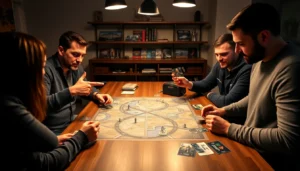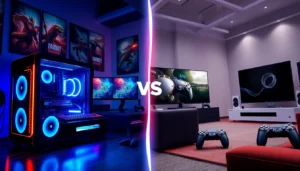Table of Contents
ToggleHorror simulation games are like a rollercoaster ride for your nerves, offering a thrilling blend of fear and excitement that keeps players on the edge of their seats. Imagine stepping into a world where every creak and shadow sends shivers down your spine. These games don’t just push the envelope—they rip it apart, inviting players to confront their deepest fears in the most immersive ways possible.
Overview Of Horror Simulation Games
Horror simulation games offer immersive experiences that engage players in terrifying narratives. Players navigate unsettling environments filled with suspense, often triggered by realistic sounds and visuals. Encountering sinister creatures or unexpected twists heightens anxiety, drawing players into the storyline.
Many horror simulation games focus on atmosphere, creating a sense of dread through detailed graphics and sound design. For instance, titles like “Amnesia: The Dark Descent” and “Outlast” exemplify these elements by using darkness and isolation. These games encourage exploration, compelling players to investigate their surroundings while remaining cautious of lurking dangers.
Psychological themes frequently emerge in horror simulations. Complex narratives often explore fear’s impact on the human mind, pushing players into moral dilemmas. In games like “Soma,” players must confront philosophical questions intertwined with horror, enhancing the emotional depth.
Game mechanics also contribute to the horror experience. Resource management can increase tension, forcing players to make difficult choices. Limited ammunition or dwindling health amplifies the feeling of vulnerability, reflecting real-life fears of helplessness.
Multiplayer elements in some horror simulation games add an extra layer of engagement. Titles such as “Phasmophobia” let players work together to uncover paranormal activities, fostering camaraderie amid fear. Shared experiences can intensify the horror, as players rely on each other’s strengths to survive.
Overall, horror simulation games push boundaries in storytelling and gameplay. Players seek thrilling narratives that elicit genuine emotions and provoke thought. The genre continues to evolve, introducing innovative gameplay techniques that captivate both new and veteran gamers.
Key Features Of Horror Simulation Games
Horror simulation games excel in creating intense experiences that keep players on the edge of their seats. These titles often showcase several key features that enhance the gameplay.
Immersive Storytelling
Storytelling immerses players in narratives packed with tension. Each plot twist heightens emotional engagement and fuels suspense. Characters develop through chilling encounters, propelling the story forward. Decisions made impact outcomes, offering players a sense of agency. Themes delve into fear, survival, and morality, prompting players to confront their darkest instincts. Games like “Amnesia: The Dark Descent” use backstory to craft intriguing mysteries that intertwine with gameplay, making every encounter significant.
Realistic Sound Design
Sound design plays a crucial role in horror simulation games. Every creak and whisper builds an unsettling atmosphere. Players become acutely aware of their surroundings through expertly layered audio cues. Sudden noises create jump scares that elicit visceral reactions. Quality soundtracks amplify emotional moments, while silence can invoke dread. Titles such as “Outlast” demonstrate how even ambient sounds contribute to tension, ensuring players remain constantly alert to potential threats. Enhanced audio immerses players deeper into terrifying worlds, shaping their overall experience.
Popular Horror Simulation Games
Horror simulation games captivate players with their unique blend of fear-inducing elements and storytelling. Notable titles in this genre deliver intense experiences that test the limits of bravery.
Game 1: Overview and Features
Amnesia: The Dark Descent serves as a hallmark of horror simulation. Players navigate through a dark mansion, shrouded in mystery. Immersive sound design amplifies fears, with each creak echoing in the silence. Resource management plays a critical role; players must conserve lantern oil and evade monsters. The gripping narrative unfolds through diary entries, deepening emotional engagement. Psychological horror combines with stunning visuals to create a suspenseful atmosphere, leaving players on edge.
Game 2: Overview and Features
Outlast stands out for its disturbing environment set in an abandoned asylum. Players assume the role of a journalist equipped only with a night vision camcorder. Tension escalates as situations demand stealth over combat. Every sound, from distant cries to sudden bangs, inspires dread, drawing players deeper into the horrors that lurk. The story explores ethical dilemmas while unraveling chilling secrets. As players experience constant threats, engaging storytelling keeps them invested and terrified throughout their journey.
The Appeal Of Horror Simulation Games
Horror simulation games attract players through their intense emotional engagement and unique experiences. They evoke fear and excitement, providing thrilling escapism.
Psychological Thrills
Psychological thrills define the horror simulation genre. Players confront their deepest fears while navigating unsettling environments. Games like “Amnesia: The Dark Descent” utilize atmosphere and tension to evoke anxiety. Unpredictable scares keep players on edge, enhancing the overall experience. Furthermore, moral dilemmas in games such as “Soma” push individuals to challenge their values, creating deeper connections. These elements foster an immersive experience that resonates beyond just gameplay. As the narrative unfolds, players explore complex themes that heighten the psychological impact. Engaging sound design amplifies emotional responses, making every moment more impactful.
Community Engagement
Community engagement enhances the horror simulation experience. Multiplayer games like “Phasmophobia” showcase the importance of collaboration among players. As participants work together to face fear, they develop a sense of camaraderie. Shared experiences generate memorable interactions, fostering discussions and social connections. Online forums and streaming platforms facilitate conversations around strategies and game mechanics. Players often seek advice from each other, creating a space for shared knowledge. This engagement drives the popularity of horror simulation games, encouraging newcomers to join the community. The shared thrill of horror fosters a unique bond among players, as they navigate frightening scenarios together.
Future Trends In Horror Simulation Games
Emerging technologies are set to redefine horror simulation games. Virtual reality (VR) offers players an unprecedented level of immersion. Players can physically engage with their surroundings, enhancing the overall fear factor. Augmented reality (AR) expands the horror experience beyond screens, allowing real-world environments to become battlegrounds against digital horrors.
Artificial intelligence (AI) is also transforming gameplay dynamics. By using advanced algorithms, NPCs (non-playable characters) exhibit more unpredictable and realistic behaviors. This unpredictability intensifies player anxiety, making encounters feel more genuine. Additionally, customizable AI can adapt to individual player styles, enhancing replayability and personal connections to the narrative.
Evolving storytelling techniques will engage players in unique ways. Narrative-driven experiences are integrating multiple endings based on player choices. These branching paths create a more tailored experience, encouraging players to explore different outcomes. Titles that embrace this approach tend to foster deeper emotional connections, making victories and losses feel more impactful.
Furthermore, collaborations between developers and psychological experts are on the rise. These partnerships aim to incorporate authentic psychological elements into gameplay. By drawing from real-world fears, developers can craft scenarios that resonate deeply with players. This psychological authenticity enhances immersion and creates a more compelling horror experience.
Lastly, community-driven content is gaining traction. Platforms that support user-generated content allow players to share their own horror experiences, further expanding the genre. Such collaborative efforts not only foster creativity but also keep the horror simulation landscape fresh and engaging. As these trends continue to evolve, horror simulation games will undoubtedly attract a growing audience eager for innovative scares.
Horror simulation games continue to captivate players by blending fear with immersive storytelling. Their ability to evoke genuine emotions keeps gamers coming back for more adrenaline-pumping experiences. As technology advances the genre’s boundaries, players can expect even more innovative scares and engaging narratives.
The community aspect also plays a significant role in the genre’s growth. Players sharing their experiences and strategies fosters a sense of belonging, making horror simulation games a shared journey into the unknown. With the promise of evolving gameplay mechanics and psychological depth, the future of horror simulation games looks incredibly bright, ensuring that thrill-seekers will always have something to explore.




